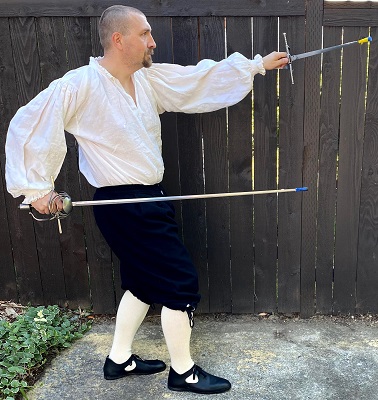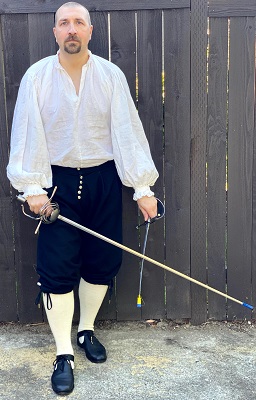Swetnam describes several alternate guards, but claims these guards are generally weaker than his true guard. All of them are more specialized than the true guard, and most are essentially nothing but invitations for specific attacks. His attitude towards guards can be summed up as follows:
“Now there be divers other guards to be used at the Rapier and Dagger, but most of them will aske a great deale more practice, to be perfect in, then this first guard, and yet not anie one of them more severe for defence both of blow and thrust then this first guarde is, and therefore, I doe account it the master guard of all other, other, yet in a Schoole, to make change of your play, the the more guard the more commendable, so they be performed with discretion and judgement: therefore I have described those which I thinke necessary…”
“…for some purposes, one guard may better serve then another: for change of guards may crosse come mens play, whereas if you use but one guard, may in often play be worne threed-bare, therefore learne as many fashions of lying with thy weapons as thou canst…”
Swetnam never mentions alternate footwork for any of these guards, but all of them work well with the footwork described earlier.
The Cross Guard

The dagger is held point-up in front of the chest, directly out from the sternum. The rapier is held with the hilt down by the right leg and the point ahead of and below the dagger hilt. The term “girdle-stead” in these descriptions refers to the belt, which at the time Swetnam was writing would be at the true waist.
“Carry the point of our dagger upright, and the hilt as low as your girdle-stead without putting your thumbe against the blade of your Dagger, but griping him fast in your hand, and the point of your Rapier under your Dagger hand according to the picture.” (p. 105)
This guard is intended to force the attacker’s blade into one of two zones, left or right of the dagger blade. The vertical dagger blade can then be swept to the left or right in an easy parry while the defender’s rapier counter-attacks. Attacks below the dagger hilt can be dealt with easily by the defender’s rapier, forcing the attacker to either retreat or disengage up into the defender’s dagger.
This guard is intended primarily as a defense against opponents who rely upon direct lunges. It is therefore particularly effective against opponents who fight in the style of Italian masters such as Capo Ferro.
“…a fore-right plaine thrust, it is with more ease defended by him which hath the perfectnesse of his guard, then it is by lying in anie other guard.”
The Forehand Guard

The Forehand guard is a variation on the Cross guard, with the rapier being held farther forward. The dagger is again held point-up in front of the chest, directly out from the sternum. The rapier is held with the hilt underneath the dagger hilt and the blade pointing forward and a little above horizontal.
“Put thy Rapier hand under the hilt of thy Dagger, alwaies keeping the point of thy Rapier something variable, and yet something directly about the girdle-stead of thy enemie, and the point of thy Dagger in a manner upright, or a verie little leaning towards thy left side, and both thy Dagger and thy Rapier hilts together, and both so low as thy girdle-stead”
It’s interesting to note that George Silver, an earlier and more traditional English fencer, also has a position titled “forehand guard”. However, Silver’s guard is quite different than Swetnam’s, and the reuse of the name demonstrates Swetnam’s habit of stealing names from other styles and misusing them, rather than any real continuity between the guards.
The Stokata Guard
 This guard is similar to the True Guard, but the rapier is held farther back and the feet are wider apart.
This guard is similar to the True Guard, but the rapier is held farther back and the feet are wider apart.
“You must (if you will frame your selfe into this gard) keepe the Dagger point out-right, and so hie as your cheeke, and your Rapier hand so farre backe, as something low as you can, and your feete three foote distance at the least, and this guard many Profeesours doe reach as the chiefe and maister guard of all other” (p. 108)
Swetnam strongly disapproves of this guard, but discusses it anyway due to its popularity at the time.
“Many have had a good opinion of the stokata gard, but (in my minde) It is more wearisome unto the bodie, and not so defensive for the body, As the first gard…”
The Careless or Lazy Guard
(Click on the image to see the technique in motion)
The Careless Guard is the quintessential one trick guard. The rapier is held with the hilt resting on the right thigh and the blade pointing horizontally to the left with the tip resting on the ground. The tip of the dagger is placed under the rapier blade.
The entire purpose of this guard is to appear relaxed and unprepared, but in fact be ready to protect yourself and attack. The idea is that when the attacker thrusts for the apparently undefended face or chest, the defender flips their rapier up with their dagger, closing the line more quickly than the attacker anticipates. The rapier hilt remains resting against the thigh to serve as a pivot point as the blade sweeps up and across the entire body. Once the rapier has cleared the attack to the right side, the defender’s dagger comes across to hold the attacker’s blade while the defender’s rapier makes an Imbrokata.
“Lay thy point of your Rapier upon the ground a foote wide of your left side overthwart your bodie, and let the hilt of your rapier rest upon your right thigh, and your dagger under your rapier about a foot forward of the hilt, and so leaving your whole belly or brest, will seeme a verie faire baite for your enemie to thrust at, but when hee chargeth you with a thrust, your defence must bee by the lifting up of your Rapier point, with your Dagger, throwing him over towards your right side, but lift not up your Rapier hand in the time of your defence in anie case, for so it may endanger the face, but so soone as you have turned it cleere over your bodie with both your weapons as aforesaid (it may be done with one of them, but not so sure as will both together) then upon your defence recover your point hastily againe and chop him in with an over-hand thrust, turning your knuckles upwards into his right shoulder where you may easily hit him if you bee quicke in taking your time before hee recover his distance, or get out of your reach.” (p. 110)
The Broad ward
(Click on the image to see the technique in motion)
The Broad ward is another one trick guard. Both arms are held at shoulder height, fully extended a little wide of straight-forward. This is intended to draw an attack on the exposed chest or stomach, which can be parried by a single sweeping dagger parry clearing the attack to the defender’s right side, followed by an imbrokata.
“Beare out both your armes right out from your bodie stiffe at the armes end, and a foote at the left a sunder, and turne both the Rapier and Dagger hilts so high as your brest or hier, leaving all your bodie open, or ungarded to seeme to, and when your enemie doth charge you with a thrust, strike it with your Dagger towards your right side, and withall answere him againe with an over-hand thrust unto his Dagger shoulder, but you must keepe your thumb upon the blade of your rapier, so then shall you put in your thrust the more steddier, and the more stronger.” (p. 112)
Mountanto
Swetnam lists the Montanto under “thrusts” rather than “guards”, but its initial position is sufficiently different than his true guard that I have moved it here. The movement described is essentially similar to the Lazy guard, but starts from a near crouch. Starting from the True guard, drop the rapier point until it touches the ground and sink as far down on your left leg as possible. This is intended to draw an attack towards the exposed body, which can be parried with a sweeping dagger parry to the right side, followed by an imbrokata.
The term “montante” is used by Italian fencing masters to refer to an upwards cut, and Swetnam is clearly continuing the English habit of appropriating and misusing others’ fencing terminology.
“The Mountanto is to be put in with a good celeritie of the bodie and in this manner, you must frame you guard when you intend to charge your enemie with this thrust, beare your Rapier hard upon, or so neere the ground as you can, lying verie low with your bodie, bowing your left knee verie nere the ground also, and either upon your enemies thrust or in lying in his guard you may strike his rapier point towards your right side with your dagger so that is may passe cleere under your rapier arme, and with same motion as you strike his rapier, sodainely mount up your rapier hand higher then your head, turning your knuckles upward, but turne the point of your Rapier downwards over his Rapier arme into his breast or shoulder, and you must be quicke in the performance of this thrust, and likewise nimbly you must leape out againe. This thrust must bee put in by the stepping forward of your left leg” (p. 114)

